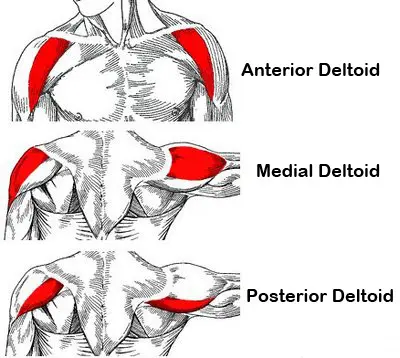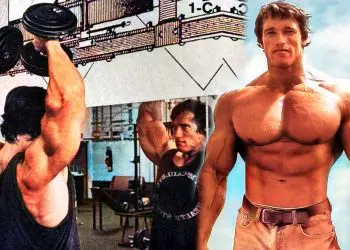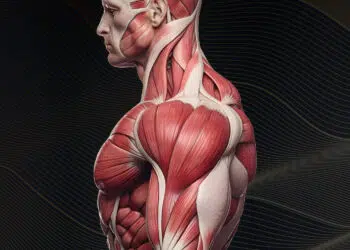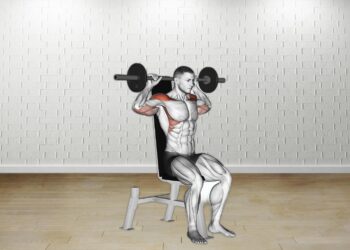If you want to build massive, powerful shoulders, you need to include some kind of overhead press in your workouts. Overhead presses are proven shoulder mass builders, and there are plenty of variations to choose from, including:
But, while each of these exercises is a viable alternative to standard overhead presses, most only involve a slight variation in technique; they’re all still overhead presses. If you keep on doing the same exercises over and over, eventually, your progress will start to stall and could plateau entirely.
One way to maintain your progress and keep building bigger, stronger muscles is to use other training tools.
One option is to do more cable machine exercises.
Cable exercises allow you to hit your deltoids from multiple angles, avoiding plateaus and sculpting 3-D delts in the process. If you really want to build boulder shoulders, cable training is a must.
In this article, we reveal the 11 most essential cable shoulder exercises for stronger, more muscular deltoids.
Level Up Your Fitness: Join our 💪 strong community in Fitness Volt Newsletter. Get daily inspiration, expert-backed workouts, nutrition tips, the latest in strength sports, and the support you need to reach your goals. Subscribe for free!
Effective Cable Shoulder Exercises
Not sure how to build your deltoids using cables instead of free-weights? Here are 11 of the most essential cable shoulder exercises! Use them in conjunction with barbell and dumbbell overhead presses or as an alternative.
- Cable Overhead Press
- Cable Face Pull
- Cable Single-Arm Lateral Raise
- Cable Bent-Over Reverse Flye
- Cable Crossover Lateral Raise
- Cable Crossover Reverse Fly
- Cable Front Raise
- Cable Upright Row
- Cable Cuban Press
- Cable Supine Reverse Flye
- Cable External Shoulder Rotation
1. Cable Overhead Press
Unlike most overhead press variations, this exercise works your anterior and posterior deltoids pretty equally. That’s because you’ll need to use your rear delts to stop your arms from falling forward as you use your anterior deltoids to push the weight up. This is a very joint-friendly overhead pressing variation.
How to do it:
- Attach a straight bar to a low cable. Grip the handle with an overhand, slightly wider than shoulder-width grip. Curl or clean the handle up to your shoulders.
- Brace your core, pull your shoulders down and back, and stand with your feet roughly shoulder-width apart.
- Press the handle up and overhead to arms’ length. Push the handle backward as well as up.
- Lower the bar back to your shoulders and repeat.
2. Cable Face Pull
Face pulls target the posterior deltoids, middle trapezius, and rhomboids. As such, it’s an excellent posture exercise. Ensure the tension stays on the target muscles by keeping your arms up and level with your shoulders and your torso upright. If you lean forward or drop your arms, the tension will move from your posterior deltoids, mid-traps, and rhomboids and onto your lats.
Learn how to do cable face pulls here.
3. Cable Single-Arm Lateral Raise
While there is nothing wrong with dumbbell lateral raises, using freeweights means that muscle tension peaks at the top of each rep and then all but vanishes when you lower your arms back to your sides. Using cables keeps your muscles under tension for the entire rep, which should be better for hypertrophy. Training one side at a time means you can really focus on your medial deltoid and ensure that both shoulders are trained equally.
Find out more about cable single-arm lateral raises here.
5. Cable Bent-Over Reverse Flye
Bent over reverse flyes are typically done using dumbbells, but they’re actually far better done using a cable machine. Not only does using cables keep your rear deltoids under constant tension, but they also allow you to use a wider range of motion. As an added benefit, this variation is also more lower back-friendly than the freeweight variation.
How to do it:
- Stand in the middle of a cable crossover machine with the handles at the bottom. Hold the left handle in your right hand and the right handle in your left hand, so the cables cross in front of you.
- Position your feet, so they’re about shoulder-width apart, knees slightly bent.
- Hinge forward from your hips and lean over until your upper body is roughly parallel to the floor. Do not round your lower back. Brace your core.
- Open your arms and extend them back until they form a T-shape. Pull your shoulders back and together.
- Lower your arms, allowing them to cross over if you wish.
- Repeat for the required number of repetitions.
4. Cable Crossover Lateral Raise
No time to train one deltoid at a time? This is the exercise for you. Stand in the middle of a cable crossover machine and use both bottom pulleys to work your left and right medial deltoids simultaneously.
Learn how to do this time-efficient medial deltoid exercise here.
6. Cable Crossover Reverse Fly
This posterior deltoid exercise is a lot like #5, but it’s done standing upright instead of leaning forward. Many exercisers will find this position more comfortable as it places less stress on your lower back.
How to do it:
Level Up Your Fitness: Join our 💪 strong community in Fitness Volt Newsletter. Get daily inspiration, expert-backed workouts, nutrition tips, the latest in strength sports, and the support you need to reach your goals. Subscribe for free!
- Stand in the middle of a cable crossover machine with the handles at the top. Hold the left handle in your right hand and the right handle in your left hand, so the cables cross in front of you.
- Position your feet, so they’re about shoulder-width apart, knees slightly bent.
- Your hands should be extended in front of your shoulders, elbows slightly bent but rigid. Brace your core.
- Open your arms and extend them back until they form a T-shape. Pull your shoulders back and together.
- Return to the starting position and repeat.
7. Cable Front Raise
Cable front raises hit your anterior deltoids. Doing them with a cable rather than dumbbells means your deltoids are under almost constant tension. It’s also harder to cheat with this exercise than it is when using free-weights. All in all, this is a very effective anterior deltoid exercise.
How to do it:
- Attach a rope handle or straight bar to a low pulley machine. Stand astride the cable with your back to the weight stack. Grab the handle and stand up. Bend your knees slightly for balance and hold the handle in front of your hips.
- With your core braced and arms slightly bent but rigid, raise your arms forward and up until they’re roughly parallel to the floor.
- Return to the starting position and repeat.
8. Cable Upright Row
Upright rows work all three deltoid heads with an emphasis on your medial and posterior deltoids. While you can do this exercise with a barbell or EZ bar, it’s usually more comfortable and shoulder-friendly using a cable machine. Use a straight bar or, if you really want to be kind to your shoulders, a rope handle.
Find out more about this exercise here.
9. Cable Cuban Press
The Cuban press is a unique shoulder exercise in that it works all three deltoid heads simultaneously. If you are short of time but still want a comprehensive shoulder workout, this could be the perfect solution. While the Cuban press is typically done using a barbell or dumbbells, it can also be done using a low cable machine and a revolving bar.
How to do it:
- Attach a straight, revolving bar to a low pulley. Alternatively, if using a dual low-cable machine, you can use two D-shaped handles.
- Hold the bar/handles in front of your thighs with an overhand, slightly wider than shoulder-width grip. Brace your core.
- Bend your arms and upright row the bar up to your sternum.
- Next, rotate your arms out and away, raising the bar to your forehead.
- Finally, press the handle up and overhead to arms’ length.
- Return to the starting position by reversing this motion.
10. Cable Supine Reverse Flye
The cable supine reverse flye is an effective isolation exercise for the posterior deltoids. Done lying flat on a bench, it provides lots of support for your lower back and also stops you from cheating as you cannot use your legs or upper body to help raise the weight.
Learn how to do this unusual but effective exercise here.
11. Cable External Shoulder Rotation
While this exercise won’t do much for the size of your shoulders, it could help improve shoulder joint health. Most chest and many shoulder exercises involve medial or inward rotation. This can cause imbalances within the rotator cuff, which is a group of small muscles that stabilize and control the finer movements of the shoulder joint. Cable external shoulder rotations are the antidote to all that medial rotation. They could also help prevent or alleviate the shoulder pain caused by rotator cuff imbalances.
Learn how to do this beneficial exercise here.
Deltoid Anatomy

Your shoulders, correctly called the deltoids, are made up of three sets of fibers or heads. These heads can work together, but it’s also possible to emphasize each one with specific movements and exercises. That’s because each deltoid head has a unique function.
As such, when designing your deltoid workout, it’s essential to choose the right exercise for the deltoid head you want to develop.
Anterior deltoids – located on the front of your shoulders, the anterior deltoids are responsible for flexion, horizontal flexion, and internal rotation of the shoulder joint.
Of all the deltoids, this is the head most likely to be overdeveloped. Why? Because it’s involved in every chest exercise you do. Acting as a synergist or helper muscle, the anterior deltoids work with your pecs whenever you do bench presses, push-ups, flyes, dips, or crossovers. It’s a hard-worked muscle! Subsequently, a lot of lifters already have well-developed anterior deltoids.
The medial deltoids – located on the side of your shoulders, this is the deltoid head that gives your shoulders their width. Big medial deltoids help create that V-taper that looks so good and makes your waist appear narrower. The function of the medial deltoid is the abduction of the shoulder joint. That means it raises your upper arm up and out to your side.
The posterior deltoids – located on the back of your shoulders, the posterior or rear delts oppose the anterior deltoid. They are responsible for extension, horizontal extension, and external rotation of the shoulder joint.
While the anterior deltoid is usually the most well-developed deltoid head, the posterior deltoid is often the least developed. As such, for many lifters, this head needs extra attention.
Not training the posterior deltoid enough can affect the appearance and function of your shoulders. It’s an essential postural and stability muscle. If its development lags too far behind the anterior deltoid, the shoulder joint can become unbalanced.
More Resources on Shoulder Exercises:
- Best Rear Deltoid Exercises
- Best Front Delt Exercises
- Best Side Delt Exercises
- Best Shoulder Exercises For Powerful Delts
- Build Bigger Shoulders: Overhead Press Hypertrophy
- Overhead Barbell Press Variations
- 13 Ways to Avoid Shoulder Pain
Cable Shoulder Exercises – Wrapping Up
All types of overhead press will help you develop bigger, stronger shoulders. But, if you want to build quality mass and deltoids that look good from the front, side, and back, you’ll need more variety on your shoulder workouts.
Dumbbell lateral, front, and bent-over raises are all excellent options. But, if you really want to maximize your deltoid development, cables are the way to go. Using cables, you can keep all the tension on the muscles you want to work, and most cable exercises are all but cheat-proof, too, so your workouts will be more effective.
So, if you are serious about building the best shoulders possible, it’s time to get serious about cable training. They are the ultimate tool for sculping your best-ever deltoids.
Interested in measuring your progress? Check out our strength standards for Bench Press, Push Ups, Face Pull, and more.








